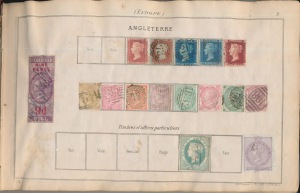Most fans of philatelic history— that is, the history of collecting stamps rather than the stamps themselves— have learned what they know through hands on work with stamps. There are very few books that retell the evolution of our hobby. Largely, it is learned by reading old journals, looking at old auction catalogs, and stamp dealer price lists and general catalogs. By looking at subscription numbers and membership evaluations, by perusing older collections and seeing how collecting goals have changed over the years, by analyzing what was being offered and to whom, a person who wishes to gather some knowledge on this topic is able to piece together, from the physical historical record, some ideas on what the hobby was and what it has become.
 Justin Lallier was the first stamp album producer, and here is one of his earliest stamp albums, printed in 1862, just a bit more than twenty years after the first postage stamp. The album is about 150 pages, showing that even by just twenty years into stamp issuance there was already a very wide body of material to collect. The album has spaces for all the stamps issued to that time and is not illustrated (Anti-counterfeiting enforcement at the time was spotting and arbitrary, and it was not really until the early twentieth century that most album and catalog producers felt comfortable illustrating most stamps). There are spaces for envelope stamps, and already the album makers were identifying special service stamps and locals. The album has very narrow spaces for the perforated stamps showing that collectors were expected to trim their stamps to fit the album and that perforated stamps often had their perforations clipped off. The stamps are glued into the album, and if the stamps are to be removed the album must be destroyed and the stamps soaked off. Mint stamps then will no longer have gum.
Justin Lallier was the first stamp album producer, and here is one of his earliest stamp albums, printed in 1862, just a bit more than twenty years after the first postage stamp. The album is about 150 pages, showing that even by just twenty years into stamp issuance there was already a very wide body of material to collect. The album has spaces for all the stamps issued to that time and is not illustrated (Anti-counterfeiting enforcement at the time was spotting and arbitrary, and it was not really until the early twentieth century that most album and catalog producers felt comfortable illustrating most stamps). There are spaces for envelope stamps, and already the album makers were identifying special service stamps and locals. The album has very narrow spaces for the perforated stamps showing that collectors were expected to trim their stamps to fit the album and that perforated stamps often had their perforations clipped off. The stamps are glued into the album, and if the stamps are to be removed the album must be destroyed and the stamps soaked off. Mint stamps then will no longer have gum. The evolution of collector tastes shows clearly in this 150 year old document. We used to collect the world; we now collect largely by country. We used to collect mint and used indiscriminately; most collectors now collect one or the other, and we used to care very little for quality. Philately as it is practiced today has a long past. It has evolved and is continuing to do so even now. The point of knowing where the hobby has been is to help us better guess where it is going.
The evolution of collector tastes shows clearly in this 150 year old document. We used to collect the world; we now collect largely by country. We used to collect mint and used indiscriminately; most collectors now collect one or the other, and we used to care very little for quality. Philately as it is practiced today has a long past. It has evolved and is continuing to do so even now. The point of knowing where the hobby has been is to help us better guess where it is going.
